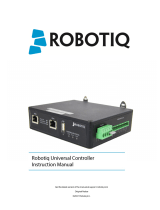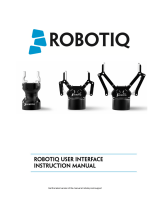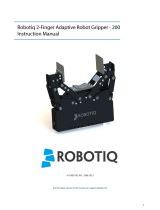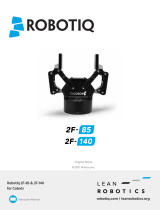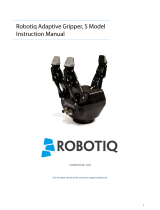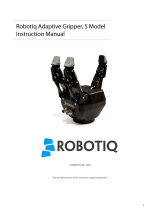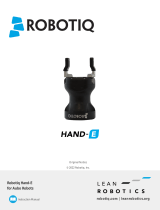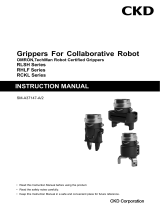Page is loading ...

Get the latest version of the manual at support.robotiq.com

3-Finger Adaptive Robot Gripper Instruction Manual
Table of Contents
Table of Contents 2
Revisions 4
1. General Presentation 6
2. Safety 11
2.1 Warning 12
2.2 Intended Use 13
3. Installation 14
3.1 Scope of delivery 14
3.2 Environmental and operating conditions 14
3.3 Mechanical connections 15
3.4 Power supply specifications 15
3.5 Wiring 16
3.5.1 Power connection 17
3.5.2 Communication connection 18
3.6 Installation for Universal Robots 25
3.6.1 Communication 25
3.6.2 Configuring the IP address of the Gripper 25
3.6.3 Configuring the UR controller network 26
3.6.4 URCaps Package 26
3.6.5 Setting the Gripper's IP address in the UR controller 28
3.6.6 Setting Modbus Unit 29
3.7 License Agreement 31
4. Control 33
4.1 Overview 33
4.2 Status LEDs 34
4.2.1 Supply LED 34
4.2.2 Communication LED 35
4.2.3 Fault LED 35
4.3 Gripper register mapping 35
4.4 Robot output registers & functionalities 36
4.5 Robot input registers & status 40
4.6 Control logic - example 44
4.7 MODBUS RTU communication protocol 45
4.7.1 Connection setup 45
4.7.2 Read holding registers (FC03) 46
4.7.3 Preset single register (FC06) 46
4.7.4 Preset multiple registers (FC16) 47
4.7.5 Master read&write multiple registers (FC23) 48
4.7.6 Modbus RTU example 49
4.8 MODBUS TCP communication protocol 55
4.8.1 Connection Setup 55
4.8.2 Read Input Registers (FC04) 55
©Robotiq inc. 2008-2021 2

3-Finger Adaptive Robot Gripper Instruction Manual
4.8.3 Preset Multiple Registers (FC16) 56
4.8.4 Modbus TCP example 57
4.8.5 Application with Universal Robots 64
4.9 Control over Universal Robots with URCaps 65
4.9.1 3F Gripper Activate node 65
4.9.2 3F Gripper Move node 65
Features 66
4.9.3 3F Object Detected node 66
4.9.4 Script functions 67
4.10 Control over ROS 68
5. User Interface 69
6. Specifications 70
6.1 Technical dimensions 70
6.2 Mechanical specifications 71
6.3 Design and customization 74
6.3.1 Finger pad replacement and customization 74
6.3.2 Palm pad replacement and customization 76
6.3.3 Fingertip replacement and customization 78
6.4 Moment of inertia and center of mass 80
6.5 Electrical ratings 81
6.6 Couplings 82
6.6.1 Blank coupling 82
6.6.2 Yaskawa SDA-5D_10D coupling 83
6.6.3 Dimensions for custom coupling 84
7. Maintenance 85
7.1 Gripper Cleaning 86
7.2 Applying Grease 87
7.3 Periodic Inspection 88
7.4 Finger Pad Replacement 89
7.5 Gripper Palm Replacement 90
7.6 Fingertip Replacement 91
7.7 Gear replacement 92
7.8 Overhaul 93
8. Spare Parts, Kits and Accessories 94
9. Troubleshooting 97
10. Warranty 99
11. Contact 100
EC Declaration of Conformity 101
©Robotiq inc. 2008-2021 3

3-Finger Adaptive Robot Gripper Instruction Manual
Revisions
Robotiq may modify this product without notice, when necessary, due to product improvements, modifications or changes in specifications. If such
modification is made, the manual will also be revised, see revision information. See the latest version of this manual online at support.robotiq.com.
Revision 2021-05-19
Updated section: Warranty Patent
Revision 2020-12-08
Section added: Setting Modbus Unit
Canopen legal mention added.
Revision 271118
Section added: Control over ROS subsection
Revision 180116
Section added: Installation for Universal Robots subsection
Section added: URCaps Package subsection
Section added: Setting the Gripper's IP address in the UR controller subsection
Section added: License Agreement subsection
Section added: Control over Universal Robots with URCaps subsection
Revision 140613
Update for Robotiq Adaptive Gripper S-7
Revision 130607
Annex added : EC incorporation
Section added : Maintenance subsection
Section added : Spare parts, Kits and Accessories
Section added : Design and customization
Revision 130206
Section added : Troubleshooting
Section added : Communication with UR robots
Minor modifications
Revision 121031
Update for Robotiq Adaptive Gripper S-6
Revision 120209
Update for Robotiq Adaptive Gripper S model 5.1
Revision 120118
Update for Robotiq Firmware 3.0
Revision 111031
Sections added: User Interface and MODBUS TCP communication protocol
Revision 110515
Manual release
Copyright
© 2008-2021 Robotiq Inc. All rights reserved.
This manual, and the product it describes, are protected by the Copyright Act of Canada, by laws of other countries, and by international treaties, and
therefore may not be reproduced in whole or in part, whether for sale or not, without prior written consent from Robotiq. Under copyright law, copying
includes translation into another language or format.
Information provided by Robotiq in this document is believed to be accurate and reliable. However, no responsibility is assumed by Robotiq for its use.
There may be some differences between the manual and the product if the product has been modified after the edition date.
The information contained in this document is subject to change without notice.
©Robotiq inc. 2008-2021 4

3-Finger Adaptive Robot Gripper Instruction Manual
Copyright
© 2021 Robotiq Inc. All rights reserved.
This manual and the product it describes are protected by the Copyright Act of Canada, by laws of other countries, and by international treaties, and
therefore may not be reproduced in whole or in part, whether for sale or not, without prior written consent from Robotiq. Under copyright law, copying
includes translation into another language or format.
Information provided by Robotiq in this document is believed to be accurate and reliable. However, no responsibility is assumed by Robotiq for its use.
There may be some differences between the manual and the product if the product has been modified after the edition date.
The information contained in this document is subject to change without notice.
©Robotiq inc. 2008-2021 5

3-Finger Adaptive Robot Gripper Instruction Manual
1. General Presentation
The terms "Gripper", "Adaptive Gripper", "Robotiq Gripper" , "S-Model", "3-Finger Gripper" and "Robotiq Adaptive Gripper" used in the following
manual all refer to the Robotiq 3-Finger Adaptive Robot Gripper. The Robotiq 3-Finger Adaptive Robot Gripper is a robotic peripheral that is designed
for industrial applications. Its design makes it a unique robotic end-of-arm tool to pick, place and handle a large range and volume of parts of varying
sizes and shapes.
Note
The following manual uses the metric system, unless specified, all dimensions are in millimeters.
Note
The following section presents the key features of the Gripper and should not be considered as being related to Gripper operation, each
feature is detailed in the appropriate section of the manual. Safety guidelines must be read and understood before any operation is attempted
with the Gripper.
The Adaptive Gripper has three articulated fingers, i.e. Finger A in front of Finger B and Finger C, that each have three joints (three phalanxes per
finger), as shown in Figure 1.1. The Gripper can engage up to ten points of contact with an object (three on each of the phalanges plus the palm). The
fingers are under-actuated, meaning they have fewer motors than the total number of joints. This configuration allows the fingers to automatically
adapt to the shape of object they grip and it also simplifies the control of the Gripper.
Figure 1.1 : The Robotiq 3-Finger Adaptive Robot Gripper.
©Robotiq inc. 2008-2021 6

3-Finger Adaptive Robot Gripper Instruction Manual
Two different types of movements can be performed with the Gripper. The first determines the type of grip being used and simultaneously changes
the orientation of Fingers B and C as shown in Figure 1.2. This movement is referred to as the 'Operation Mode'. The Operation Mode is determined
by the user prior to the grip as a function of the size or shape of the object being gripped and for the task that has to be done.
Figure 1.2 : First type of movement for the 3-Finger Adaptive Robot Gripper: changing the Operation Mode.
Operation Modes:
1. The basic mode is the most versatile Operation Mode. It is best suited for objects that have one dimension longer than the other two. It can grip
a large variety of objects.
2. The wide mode is optimal for gripping round or large objects.
3. The pinch mode is used for small objects that have to be picked precisely. This Operation Mode can only grip objects between the distal
phalanxes of the fingers.
4. The scissor mode is used primarily for tiny objects. This mode is less powerful than the other three modes, but is precise. In scissor mode, it is
not possible to surround an object. Here, Fingers B and C move laterally towards each other while Finger A remains still.
©Robotiq inc. 2008-2021 7

3-Finger Adaptive Robot Gripper Instruction Manual
The four pre-set Operation Modes can be chosen by the user (see Figure 1.3).
Figure 1.3 : The four Operation Modes of the 3-Finger Adaptive Robot Gripper.
The second movement of the Gripper is the closing and opening of the fingers as shown in Figure 1.4. This action is performed with a single input from
the user. Each finger is not controlled independently; the Gripper itself closes each finger until it reaches a stable configuration, on an object or against
the Gripper palm. Note that a user can specify the relative speed at which the fingers will close and the relative force that will be applied to an object.
Figure 1.4 : Second movement of the 3-Finger Adaptive Robot Gripper: closing and opening the fingers.
©Robotiq inc. 2008-2021 8

3-Finger Adaptive Robot Gripper Instruction Manual
Two types of grips occur when closing the 3-Finger Adaptive Robot Gripper on an object: Fingertip Grip or Encompassing Grip.
lThe Fingertip Grip is when an object is only held by the distal phalanxes. This type of grip is similar to what is done with conventional industrial
parallel grippers. In this situation, the stability of the grip is maintained because of the friction between the fingers and the object.
lThe Encompassing Grip is when the fingers surround an object. The object is encompassed within the fingers and the stability of the grip is no
longer related to friction. We suggest using the Encompassing Grip whenever possible to increase grip stability.
Figure 1.5 shows the two types of grips.
Figure 1.5 : The Two Types of Grip, Encompassing and Fingertip Grips.
Caution
It is important to note that a parallel grip can only be performed when the fingers touch the object with the distal phalanxes first. Inversely, for
an encompassing grip, the fingers must touch the object with the proximal or the lower section of the distal phalanxes first. Also, to ensure
stability, the object should be held against the Gripper palm when performing an encompassing grip.
Note that the Encompassing Grip cannot occur in all Operation Modes. For example, in Pinch and Scissor modes, it is only possible to do Fingertip
Gripping. On the other hand, the Fingertip Grip can occur in all four Operation Modes. Figure 1.6 summarizes the Types of Grip possible for each
Operation Mode.
Info
Operation Modes are inputs to the Gripper. Whether the fingers close to produce an Encompassing or Fingertip grip is decided at the
Gripper level automatically. It will depend on:
lThe Operation Mode;
lThe part's geometry;
lThe relative position of the part with respect to the Gripper.
In other words, picking the same part using the same Operation Mode could result in either an Encompassing or Fingertip Grip based on a
part's position and geometry.
©Robotiq inc. 2008-2021 9

3-Finger Adaptive Robot Gripper Instruction Manual
Figure 1.6 : Operation Modes vs. Types of Grip.
©Robotiq inc. 2008-2021 10

3-Finger Adaptive Robot Gripper Instruction Manual
2. Safety
Warning
The operator must have read and understood all of the instructions in the following manual before handling the Robotiq 3-Finger
Adaptive Robot Gripper.
The term "operator" refers to anyone responsible for any of the following operations on the 3-Finger Adaptive Robot Gripper:
lInstallation
lControl
lMaintenance
lInspection
lCalibration
lProgramming
lDecommissioning
This documentation explains the various components of the 3-Finger Adaptive Robot Gripper and its general operation. Please read this
documentation thoroughly and be sure to understand its contents before handling the 3-Finger Adaptive Robot Gripper.
The drawings and photos in this documentation are representative examples and differences may exist between them and the delivered product.
©Robotiq inc. 2008-2021 11

3-Finger Adaptive Robot Gripper Instruction Manual
2.1 Warning
Note
Any use of the Gripper in noncompliance of these warnings is inappropriate and may cause injury or damage.
Warning
lThe Gripper needs to be properly secured before operating the robot.
lDo not install or operate a Gripper that is damaged or lacking parts.
lNever supply the Gripper with an alternative current source.
lMake sure all cord sets are always secured at both ends, at the Gripper and at the robot.
lAlways respect the recommended keying for electrical connections.
lBe sure no one is in the robot and Gripper path before initializing the robot's routine.
lAlways respect the Gripper payload.
lSet the Gripper pinch force and speed accordingly, based on your application.
lKeep fingers and clothes away from the Gripper while the power is on.
lDo not use the Gripper on people or animals.
lFor welding applications, make sure there are no Gripper parts on the ground path of the welding power source.
lInappropriate use of the Gripper may cause injury or damage.
Warning
Concerning Gripper use on a robot:
lMake sure all cord sets are always secured at both ends, at the Gripper and at the robot.
lAlways handle the Gripper outside the robot danger zone for maintenance and inspection work or ensure complete shutdown of the
robot.
lFor welding applications, make sure there are no Gripper parts on the ground path of the welding power source.
lThere is a risk that an object might be dropped or catapulted by the Gripper during use with a robot, precautions must be taken to prevent
any possible injury.
©Robotiq inc. 2008-2021 12

3-Finger Adaptive Robot Gripper Instruction Manual
2.2 Intended Use
The Gripper unit is designed for gripping and temporarily securing or holding parts.
Caution
The Gripper is NOT intended for applying force against objects or surfaces.
The product is intended for installation on a robot or other automated machinery and equipment.
Note
Always comply with local and/or national laws, regulations and directives on automation safety and general machine safety.
The unit may be used only within the range of its technical data. Any other use of the product is deemed improper and unintended use. Robotiq will not
be liable for any damages resulting from any improper or unintended use.
©Robotiq inc. 2008-2021 13

3-Finger Adaptive Robot Gripper Instruction Manual
3. Installation
Warning
Be sure to read and understand the safety instructions related to the 3-Finger Gripper prior to installation.
Warning
Do not operate the Gripper, or even turn on the power supply, before it is firmly anchored. The Gripper fingers may move and cause injury
or damage.
3.1 Scope of delivery
Standard upon delivery:
lRobotiq 3-Finger Adaptive Robot Gripper (AGS-001-XXXX)
lReplace XXXX by one of the following communication options :
lENIP - EtherNet / IP
lMTCP - Modbus TCP
lM232 - Modbus RTU over serial 232
lM485 - Modbus RTU over serial 485
lECAT - EtherCAT
lDNET - DeviceNet
lCANO - CANopen1
lPNET - PROFINET
lDefault fingertip (see Technical dimensions).
l5m Power cable for the 3-Finger Adaptive Gripper CBL-PWR-2054.
lUSB cable CBL-USB-2057 (for control via the Robotiq User Interface).
l5m Communication cable according to your communication protocol option.
lGrease syringe ACC-LUB-SHC1500 for maintenance.
Note
The following are not included with the delivery of the 3-Finger Adaptive Robot Gripper unless specified:
lHardware required for any of the communication options, accessories, faceplates or fixtures.
lPower supply unit, power supply wiring or fuse.
See Spare Parts, Kits and Accessories section for a list of available parts.
3.2 Environmental and operating conditions
The Gripper is designed for industrial applications. Always respect the conditions specified for storage and operating environments:
SPECIFICATION VALUE
Minimum storage/transit temperature -22°F [-30°C]
Maximum storage/transit temperature 140°F [60°C]
Minimum operating temperature 14°F [-10°C]
Maximum operating temperature 122°F [50°C]
Humidity (non-condensing) 20-80% RH
Vibration < 0.5G
Others lFree from dust, soot or water
lFree from corrosive gases, liquids or explosive gases
lFree from powerful electromagnetic interference sources
1CANopen is a registered trademark of CiA.
©Robotiq inc. 2008-2021 14

3-Finger Adaptive Robot Gripper Instruction Manual
Cleanliness of the Gripper surface influences friction between parts and the Gripper, keep your Gripper clean and away from debris
generators. Follow the specified maintenance intervals.
3.3 Mechanical connections
You must use a coupling to attach the Gripper to the robot. Be sure to use the coupling related to your robot model. If there is no coupling for your
robot, you can modify a blank coupling model or Robotiq can create a custom version based on blanks in section 6.6 for you or you can build one
based on the dimensions in section 6.6.1.1. Please see Robotiq support Options and Spare Parts section for a list of available coupling and adapters.
Here are the steps to follow for the installation of the Gripper (see Figure 3.3.1). Note that all screws must be locked in place using medium strength
thread locker (Loctite 248).
1. Screw the Coupling to your robot arm (if your cables are running through the robot, be sure to use a Coupling with a groove).
a. If you are using an Adapter Plate, it must be mounted first on the robot arm, using the dowel pins for indexing and the screws to secure
the adapter plate in place.
b. Attach the Coupling to the robot arm using the correct dowel pins for indexing.
c. Secure the Coupling with the coupling (robot) screws.
2. Insert the Gripper's Universal Wrist into the coupling and align the indexing dowel pin with the associated hole.
3. Secure the Gripper to the Coupling with the radial screws.
Figure 3.3.1 : Attaching the 3-Finger Gripper to a robot arm with the use of a Coupling.
3.4 Power supply specifications
The Gripper needs to be supplied by a DC voltage source. This power supply is not included with the Gripper. The following table shows the
specifications regarding the power supply required to operate the Gripper properly.
SPECIFICATION VALUE
Output voltage 24 V DC
Output current 2 A
Ripple 2-3 % peak-peak
Output regulation 10% maximum
Overcurrent 4 A fuse at 77°F [25°C]
©Robotiq inc. 2008-2021 15

3-Finger Adaptive Robot Gripper Instruction Manual
SPECIFICATION VALUE
Maximum fuse I2t factor 100 A2s at 77°F [25°C]
Overvoltage protection Not required1
Warning
1Always respect the ripple and output regulation tolerances on the output voltage, exceeding these limits could damage the Gripper. If your
power supply can exceed the specified regulation, overvoltage protection is required.
Robotiq recommends the use of the following power supply : TDK-Lambda DPP100 Series, 15-100W Single Output DIN Rail Mount Power Supply,
DDP100-24-1
3.5 Wiring
Two connections are needed for the 3-Finger Gripper, one for power and one for communication. On the Gripper, both are located on the Connection
Panel shown in Figure 3.5.1.
Figure 3.5.1 : Power, USB and communication receptacles shown with USB cover removed.
Connections are identified as:
lPWR for power connection.
lCOM for communication connection (depends on your chosen protocol).
lUSB for a standard USB male A jack (present on all products).
Info
Note that the communication connector (COM) shown in figure 3.5.1 will change according to the provided communication protocol. Status
LED, USB 2.0 port and power connector (PWR) are standard on every Robotiq 3-Finger Adaptive Robot Gripper.
To access the USB panel:
1. Unscrew the two 4-40 FHMS (Flat Head Machine Screws) present on the cover.
2. Remove the cover.
3. Plug in your standard Male-A USB 2.0 connector.
Tip
When closing the panel, apply low strength (pink) Loctite to the screws to prevent loosening.
Standard cables for the 3-Finger Adaptive Robot Gripper are:
l5 meters power cable
l5 meters communication cable (according to your chosen communication protocol)
©Robotiq inc. 2008-2021 16

3-Finger Adaptive Robot Gripper Instruction Manual
l5 meters USB 2.0 cable A-A male
Info
All required cables are available from Robotiq, see the Spare Parts, Kits and Accessories section.
Warning
Use proper cabling management. Be sure to have enough forgiveness in the cabling to allow movement of the Gripper along all axes without
putting tension on the cable or pulling out the connectors. Always protect the controller-side connector of the cable with a strain relief
cable clamp.
3.5.1 Power connection
Here is the way the Gripper should be connected to a power source (Figure 3.5.1.1).
Figure 3.5.1.1 : Power connection diagram of the 3-Finger Adaptive Robot Gripper.
Caution
The 4A fuse is external to the Gripper. It is not provided by Robotiq and the user is responsible for proper installation.
The pin-out of the power connectors is detailed in Figure 3.5.1.2.
©Robotiq inc. 2008-2021 17

3-Finger Adaptive Robot Gripper Instruction Manual
Figure 3.5.1.2 : Gripper Power Input and Power Connector.
Info
RS485 communication is standard on all 3-Finger Grippers, see the Serial Communication Protocol section. If not using RS485
communication, simply leave the two wires unconnected.
The 3-Finger Gripper should be supplied with cables that have the following specifications:
lApproximate length of 5 meters.
lDeviceNet standard cable.
lPower pair :
ltwo (2) #22 AWG (black and red).
lData pair :
ltwo (2) #22 AWG (blue and white).
lShield :
lFoil (data only) #22 AWG.
3.5.2 Communication connection
By default, the power receptacle of the 3-Finger Adaptive Robot Gripper handles the communication via the MODBUS RTU protocol (RS232 or
RS485). The following table summarizes the communication protocols available through the communication receptacle of the Gripper. Note that only
one other protocol option is available in a given Gripper unit (MODBUS RTU protocol always being included). The Gripper that you have was
configured before shipment with only one of the following protocols.
Family Protocol
Real-Time-Ethernet EtherNet/IP
Modbus TCP/IP
PROFINET
EtherCAT
Fieldbus DeviceNet
CANopen1
The communication cable and connectors provided with the 3-Finger Gripper model vary with the communication protocol option choice. Each
protocol has its own pin-out and cable. Provided cable has an approximate length of 5m. See details in the following sections for your communication
pinout.
Warning
Be sure to use the appropriate cables and pin-outs for your communication protocol as any other setup may damage the Gripper.
DeviceNet communication protocol
Figure 3.5.2.1 shows the pin-out for the DeviceNet communication protocol for the receptacle (male) present on the 3-Finger Adaptive Robot Gripper
and the cable (female) provided with your Gripper.
1CANopen is a registered trademark of CiA.
©Robotiq inc. 2008-2021 18

3-Finger Adaptive Robot Gripper Instruction Manual
Figure 3.5.2.1 : DeviceNet communication pinout.
The DeviceNet communication and the 3-Finger Gripper use a 24 V supply. Robotiq suggests separating the power supplies as shown in
Figure 3.5.2.2.
Caution
lThere is no terminating resistor mounted in the Gripper.
lThe shield of the cable must be grounded in the robot controller.
lFusing must be respected.
Tips
DeviceNet standard requires a 120 Ohms resistor to be mounted at the beginning and at the end of the line. If the Gripper is the end of line,
then a 120 Ohms resistor must be mounted between pin 4 and 5.
Figure 3.5.2.2 : Power connection diagram for the 3-Finger Gripper using DeviceNet Fieldbus.
©Robotiq inc. 2008-2021 19

3-Finger Adaptive Robot Gripper Instruction Manual
Factory settings for DeviceNet protocol:
Identification Settings
Info Decimal Value (base 10) Hexadecimal Value (base 16)
Vendor ID 283 0x0000011B
Product Code 35 0x00000023
Serial Number 0 0x00000000
Product Type 12 0x0000000C
Major Revision 1
Minor Revision 1
Product Name AG-DNS
BUS SETTINGS
MAC ID 11
Baud Rate 250 KBaud
DATA SETTINGS
Prod. Data Length 16
Cons. Data Length 16
CANopen communication protocol1
Figure 3.5.2.3 shows the pin-out for the CANopen communication protocol for the receptacle (male) present on the 3-Finger Adaptive Robot Gripper
and the cable (female) provided with your Gripper.
Figure 3.5.2.3 : CANopen communication pinout.
Caution
1CANopen is a registered trademark of CiA.
©Robotiq inc. 2008-2021 20
/
